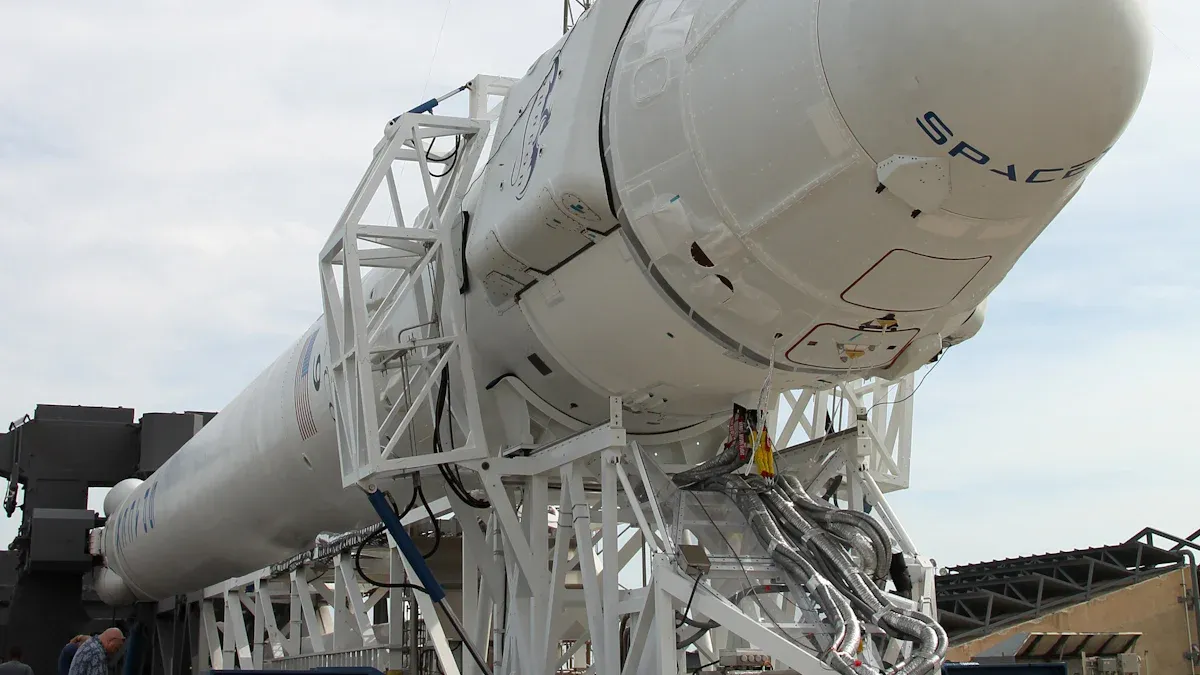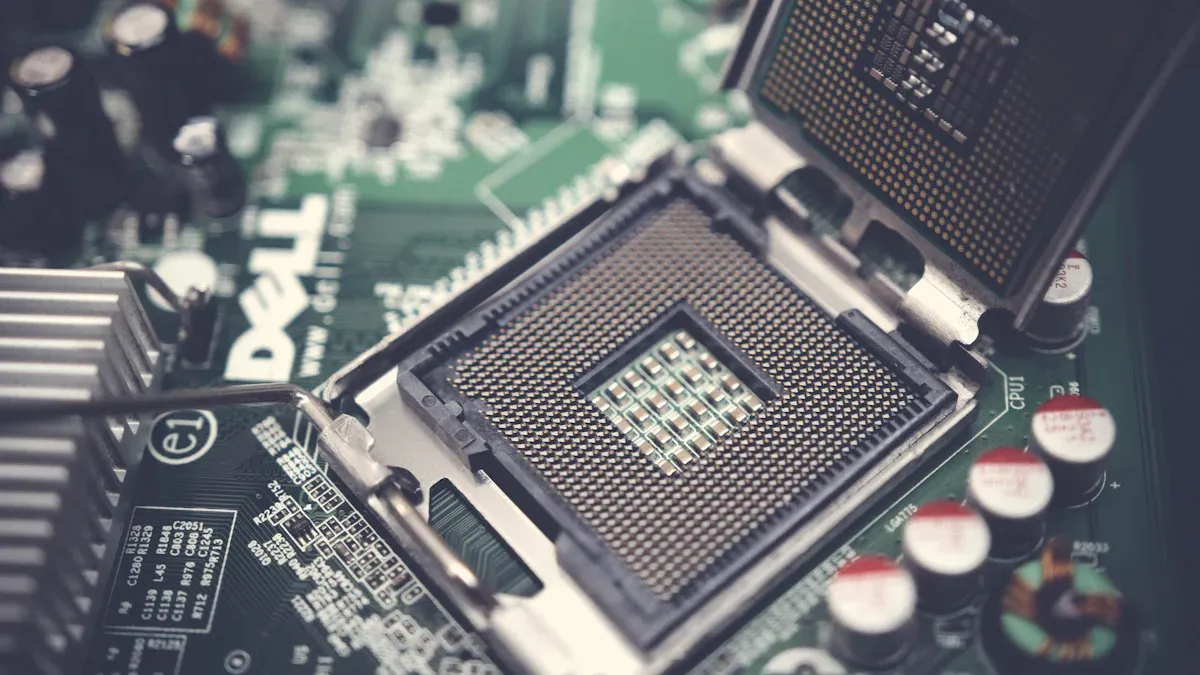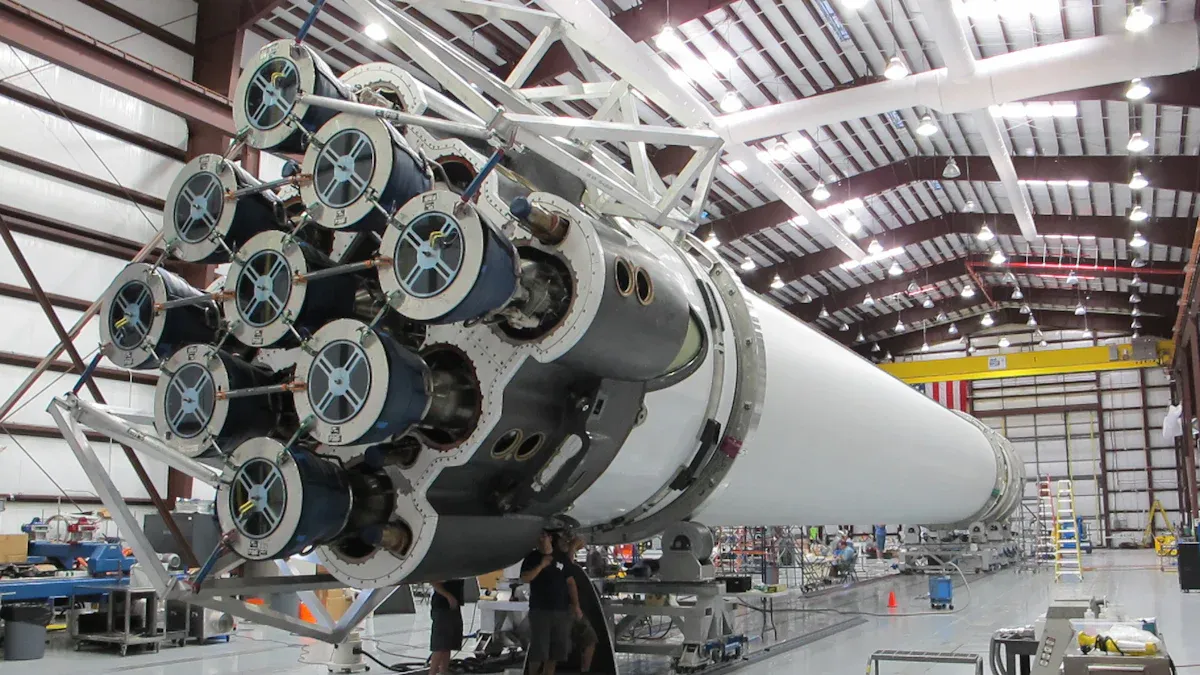
In aerospace PCBA manufacturing services, saving money is very important. Every step in the process affects the total cost. For example:
The parts list makes up 61% of the cost.
PCB materials and their production add 23%.
Assembling the parts contributes 13%.
Tools account for 3%.
Balancing good value, quality, and trust is key to saving money without sacrificing performance. Advanced tools like 3D X-ray scans can detect 98.7% of hidden problems. These tools not only help save money but also enhance product longevity. By keeping prices low and ensuring thorough quality checks, you can achieve the best results for aerospace PCBA manufacturing services.
Key Takeaways
Check if manufacturers have certifications like AS9100 and IPC Class 3. These prove their PCBs are high quality and reliable.
Look for clear prices and detailed quotes. This helps avoid surprise costs and saves money.
Pick manufacturers with good quality checks. This stops defects and makes sure PCBs work in tough conditions.
Think about using new tech like 3D printing and AI design. These can make work faster and cheaper over time.
Talk clearly with your manufacturer. This helps with design changes and getting your PCBs on time.
Key Factors to Evaluate in Aerospace PCBA Manufacturing Services
Certifications and Compliance with Industry Standards
Certifications are very important for making aerospace PCBs. Manufacturers must follow rules like AS9100 and IPC Class 3. These rules ensure the PCBs are reliable for aerospace use. The FAA also has strict rules for airplane electronics to keep them safe.
Manufacturers need to follow NIST 800-171 to protect sensitive information. This helps meet government contract rules and keeps data secure. If there’s a data breach, they must inform federal agencies. Strong security is very important for handling Controlled Unclassified Information (CUI).
Tip: Check the manufacturer’s certifications and compliance record. This helps reduce risks and ensures good value for your PCB assembly.
Quality Assurance Processes and Testing Capabilities
Quality checks make sure PCBs work well in tough conditions. Manufacturers should have strong quality programs to meet industry rules. IPC Class 2 and IPC Class 3 set different reliability levels. Class 2 is for general use, while Class 3 is for critical systems that must always work.
Testing should mimic real-world conditions to check performance. For example:
Testing operating conditions shows if parts work correctly.
Functional tests confirm everything works before shipping.
Good quality programs save money by avoiding defects and ensuring reliability. Manufacturers who focus on quality deliver PCBs that meet aerospace needs.
Standard | Description |
|---|---|
IPC Class 2 | Boards must meet basic reliability for general use. |
IPC Class 3 | Boards must work continuously for critical systems. |
Lead Times and Delivery Efficiency
Fast delivery is key to keeping projects on track. Long wait times can slow production and raise costs. Manufacturers should use Just-In-Time (JIT) inventory to avoid delays.
Good logistics planning also helps with delivery speed. Using advanced software makes transportation smoother. This reduces problems and ensures PCB assembly arrives on time.
Delivery Challenge | Description | Solution |
|---|---|---|
Lead Times | Delays in getting materials | Use JIT inventory management |
Logistics Coordination | Managing transportation plans | Use software for better planning |
Note: Pick a manufacturer with a good delivery record. This avoids delays and extra costs.
Transparency in Pricing and PCB Quote Comparison
When picking an aerospace PCB maker, clear pricing is key. Knowing the cost breakdown helps you plan and avoid surprises. Comparing prices from different makers ensures good value without losing quality.
What to Look for in a PCB Quote Comparison
To compare PCB quotes well, check these important points:
Production Capabilities: See if they handle small or complex orders. Some makers focus on certain PCBs, which affects price.
Certifications: Make sure they have AS9100 or IPC Class 3. These prove reliability but may raise costs.
Lead Times: Check delivery speed. Faster delivery might cost more, but delays can be pricey too.
Quality Standards: Ensure quality matches aerospace needs. Better PCBs cost more now but save money later.
Pricing Structure: Look for detailed costs like materials, labor, and tools. This shows where you can save.
Flexibility: See if they allow design changes without big price jumps.
Tip: Always ask for a full quote with all costs listed. This avoids surprises and helps you budget better.
Factors That Influence PCB Pricing
Many things affect the cost of aerospace PCBs. Knowing these helps you compare prices better:
Manufacturing Processes: Advanced methods like HDI cost more but work better.
Tooling and Setup Costs: Setup fees differ by maker and are higher for complex designs.
Labor Costs: Skilled workers make better PCBs but cost more.
Overhead and Profit Margins: Each maker has different running costs and profits, which change prices.
Additional Features: Extras like solder masks or cut-outs add to the cost.
By checking these, you can find the best-priced option for your needs.
Why Transparency Matters
Clear pricing builds trust and makes choices easier. When makers give clear quotes, you can compare and avoid hidden fees. It also shows if higher prices mean better quality or just extra charges. Transparent pricing helps you get the best deal for your money.
Note: Stay away from makers who won’t give full quotes. Hidden costs can ruin your budget and delay your project.
By focusing on clear pricing and comparing quotes carefully, you can balance cost and quality. This ensures your aerospace PCBs work well without costing too much.
Cost-Efficiency Analysis in Aerospace PCB Manufacturing

Material Selection and Its Impact on Long-Term Cost Efficiency
The materials used in aerospace PCBs greatly affect costs. High-quality materials may cost more at first but last longer. They also perform better, reducing the need for replacements. For aerospace, materials like lightweight composites or heat-resistant laminates are common. These materials handle tough conditions and keep the weight low.
Complex designs can raise material costs. For example, multi-layer designs need advanced materials and extra work. This increases production costs but improves functionality. In aerospace, these designs are often worth the extra expense.
Cost Factor | Description |
|---|---|
Material Costs | Money spent on raw materials for making PCBs. |
Manufacturing Costs | Costs from production, affected by design and technology. |
Design Complexity | How detailed the PCB design is, which impacts cost and ease of production. |
Tip: Talk to your manufacturer about picking materials. Choose ones that balance cost and performance for the best results.
Production Volume and Economies of Scale
How many PCBs you order affects the cost per unit. Making more PCBs at once lowers the cost per piece. This is called economies of scale. Bulk orders let manufacturers work more efficiently, cutting costs and keeping quality consistent. This is crucial for aerospace, where reliability is a must.
Ordering more PCBs lowers the cost per unit.
Bulk production helps meet demand faster.
Large orders ensure all PCBs are high quality.
The aerospace PCB market is growing. It’s expected to rise from $1.35 billion in 2024 to $1.38 billion in 2025, with a growth rate of 2.3%. This shows the need for efficient production methods.
Note: If you need fewer PCBs, ask your manufacturer about saving costs. Some specialize in small orders and can help you save money.
Identifying and Avoiding Hidden Costs
Hidden costs can mess up your budget. These costs come from unclear pricing, design changes, or missed requirements. To avoid this, ask for a detailed cost breakdown. This should include materials, labor, tools, and extra fees.
Costs for materials used in PCBs.
Expenses for parts bought from suppliers.
Manufacturing costs that depend on design complexity.
Traceability helps avoid hidden costs. It links design needs to the final product, ensuring everything meets your standards. Tools like traceability matrices can show potential problems early. Impact analysis also helps by showing how design changes affect costs, keeping your project on track.
Tip: Pick a manufacturer with strong quality checks. This reduces defects and saves money in the long run.
The Role of Advanced Manufacturing Technologies in Enhancing Efficiency
New manufacturing technologies have changed how aerospace PCBs are made. They make production faster, cut costs, and improve reliability. These tools reduce waste and ensure high quality, making them essential for aerospace.
Lightweight and High-Efficiency Alternatives
Modern ideas like ECM’s PCB Stator technology bring big benefits. This method creates lighter and more efficient parts, which is important in aerospace. Lighter parts improve performance. It also allows production at local factories, reducing the need for overseas suppliers. This speeds up delivery times. ECM’s motors are very efficient, saving energy and lowering costs. Using these technologies helps you save money and work more efficiently.
Enhanced Reliability with Conformal Coating
Conformal coating is another smart method to improve PCB reliability. It protects parts from tough conditions like heat and moisture. These are common in aerospace. The coating stops failures and keeps PCBs working longer. Adding this step to production lowers repair costs and makes products last longer.
Comparing Traditional and Advanced Manufacturing
When comparing old and new methods, the benefits of advanced tools are clear. New methods waste less material and use less energy, as shown below:
Aspect | Traditional Manufacturing | Advanced Manufacturing |
|---|---|---|
Material Waste (%) | 20 | 10 |
Energy Consumption (kWh/kg) | 25 | 15 |
These changes save money and help the environment. For small orders, advanced methods like 3D printing are cheaper, as shown here:
Production Volume | 3D Printing Cost (USD) | Traditional Manufacturing Cost (USD) |
|---|---|---|
1-10 units | 50-100 | 500-1000 |
11-100 units | 500-1000 | 2000-5000 |
101-1000 units | 2000-5000 | 10000-20000 |
This shows how advanced tools save money for small orders while keeping quality high.
AI-Driven Design for Better Efficiency
AI is changing how PCBs are designed. It helps use materials wisely and saves energy. AI designs waste less and are more efficient, as shown below:
Aspect | Traditional Design | AI-Driven Design |
|---|---|---|
Material Waste (%) | 20 | 15 |
Energy Consumption (kWh/kg) | 25 | 20 |
Using AI creates designs that cost less and are eco-friendly. This ensures your PCBs meet aerospace needs without extra expenses.
Faster Turnaround Times with Advanced Technologies
Advanced tools also speed up production by automating tasks. Automation reduces mistakes and makes work faster. This ensures PCBs are ready on time. In aerospace, delays can be very costly. Choosing a manufacturer with these tools helps you get faster results without losing quality.
Tip: Work with manufacturers who use advanced tools. This ensures your PCBs are made quickly, reliably, and affordably.
By using advanced technologies, you can save money, improve quality, and work more efficiently. These tools make production smoother and provide long-term benefits, making them a smart choice for aerospace projects.
Balancing Quality and Cost in Aerospace PCB Manufacturing

Understanding the Quality vs. Cost Trade-Off
Balancing quality and cost is very important for aerospace PCBs. High-quality PCBs cost more at first but save money later. They last longer and need fewer repairs. To decide wisely, consider these points:
Clear pricing shows where your money is spent. Detailed quotes stop surprise fees.
Strong quality checks may cost more but ensure reliability.
Faster delivery can cost extra but helps meet deadlines.
Small orders give flexibility but may raise per-unit costs.
Advanced tools improve quality but need higher upfront spending.
Tip: Think about the benefits of better quality versus lower costs. This helps you get the most for your money.
The Importance of Reliability in Aerospace Applications
Reliability is critical in aerospace. PCBs must work perfectly in tough conditions. For example:
Satellites need ESA-approved PCBs for signals and controls.
Space probes use HDI PCBs for small, strong electronics on long trips.
Earth observation systems rely on top-quality PCBs to handle harsh environments.
These examples show that reliable PCBs stop mission failures and costly fixes. Picking a manufacturer with a good track record ensures your PCBs meet aerospace needs.
Strategies for Ensuring Value Without Overspending
You can save money and still get good value by using smart ideas:
Choose materials wisely with your manufacturer to balance cost and performance.
Use Design for Manufacturing (DFM) to avoid mistakes and speed up production.
Apply Statistical Process Control (SPC) to keep quality steady during production.
Improve constantly by studying defects and customer feedback.
Working with trusted partners also helps. Companies with partnerships earn 20% more each year. These partnerships grow business and keep income steady, letting you afford high-quality PCBs without overspending.
Note: Teaming up with your manufacturer helps you make smart, cost-saving choices while keeping quality high.
Tips for Choosing the Right Aerospace PCB Manufacturer
Evaluating Communication and Responsiveness
Good communication helps you work well with your aerospace PCB maker. Clear updates keep you informed about progress and any issues. Quick replies, ideally within a day, show they care about service and efficiency.
A project manager can make teamwork even better. They ensure production stays on schedule and handle changes fast. This avoids delays and confusion, saving both time and money.
Tip: Pick a manufacturer who values clear and fast communication. This keeps you updated and prevents costly mistakes.
Assessing Flexibility in Customization and Design Changes
Being flexible with designs is very important for aerospace needs. Makers who adjust to your project’s demands are more helpful. For instance, rigid-flex PCBs work well for satellite panels. They handle vibrations and movement during launches.
New tools like 3D printing allow creative designs. These save space and reduce weight. FPGAs let you reprogram hardware, making them useful in tough conditions.
Note: Work with manufacturers who know how to customize designs. Their skills can lower costs while keeping products reliable.
Checking References and Customer Reviews
Reviews and references show if a manufacturer is reliable. Happy customers prove they deliver good quality and service. Looking at their past projects shows their experience with aerospace work.
Talking to former clients gives you real feedback on their performance. Makers who share references or reviews show they are honest and care about customer satisfaction.
Tip: Think of reference checks like hiring someone. Checking their history helps you choose a dependable partner who delivers great results without hidden fees.
Conducting a Cost-Benefit Analysis Before Making a Decision
A cost-benefit analysis helps you choose the best aerospace PCB maker. By comparing costs and benefits, you can find the smartest option. This ensures every dollar spent gives good value.
Start by involving different teams early in planning. Engineers, designers, and buyers working together can avoid costly mistakes. Using Design for Manufacturing (DFM) ideas can simplify designs. Simple designs cost less and are easier to make.
Picking the right materials is also important. Using common parts instead of custom ones saves money. These parts are easier to find, cutting wait times and surprise costs. Making PCBs in big batches lowers the cost per piece. Bulk production keeps quality steady and uses resources better.
Think about long-term costs too. A lifecycle cost check looks at future repairs or upgrades. Spending more now on strong materials and good designs saves money later. This keeps your PCBs working well for a long time.
Advanced tools like 3D printing and AI design can also help. They may cost more upfront but speed up production and reduce waste. These tools make work faster and cheaper in the long run.
By doing a cost-benefit analysis, you can balance cost and quality. This way, your aerospace PCBs meet high standards without going over budget.
Picking the right aerospace PCB maker needs careful thought. Look for certifications, strong quality checks, and fast delivery to ensure reliability. Clear pricing and new technologies help control costs. Companies like Aero-Space and HEICO Corporation focus on reliable parts and custom solutions for aerospace.
Balancing cost and quality is very important. Using strong materials and modern methods saves money over time. A smart plan, like doing a cost check and working with skilled makers, helps your PCBs meet aerospace rules without spending too much.
Tip: Choose makers who value new ideas and dependability for the best project results.
FAQ
1. What certifications should you look for in an aerospace PCB manufacturer?
Look for AS9100 and IPC Class 3 certifications. These prove the manufacturer follows strict rules for quality and safety. They ensure the PCBs are reliable for aerospace use.
2. How can you avoid hidden costs when choosing a PCB manufacturer?
Ask for a clear cost breakdown. Make sure it lists materials, labor, tools, and extra fees. This helps you spot hidden costs and plan your budget better.
3. Why is material selection important for aerospace PCBs?
Materials affect how strong, light, and durable PCBs are. Good materials like heat-resistant laminates work well in tough conditions. Talk to your manufacturer to pick materials that balance cost and performance.
4. What role does advanced technology play in PCB manufacturing?
New tools like 3D printing and AI design make production faster. They cut waste, lower costs, and improve quality. These technologies are great for aerospace projects.
5. How can you ensure timely delivery of aerospace PCBs?
Pick manufacturers with good delivery systems and JIT inventory plans. These methods reduce delays and keep your project on schedule.
See Also
Locating The Ideal PCBA Manufacturer To Meet Your Requirements
Speeding Up PCBA Production While Maintaining High Quality
Excelling In PCBA Manufacturing Methods For Superior Outcomes
Cost-Effective Strategies For Optimizing Small Batch PCBA Production





